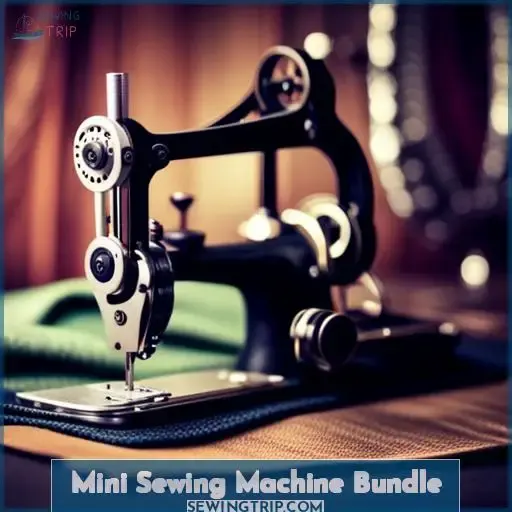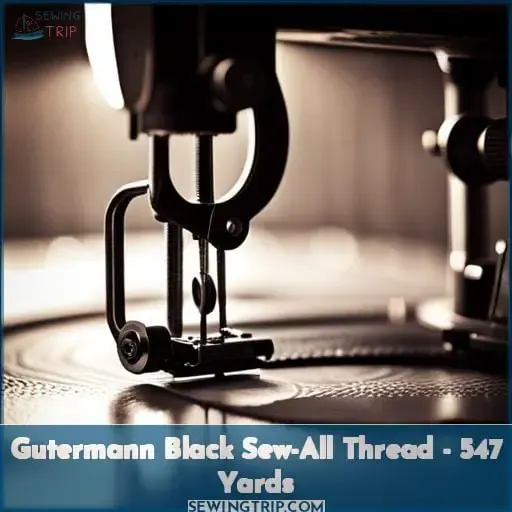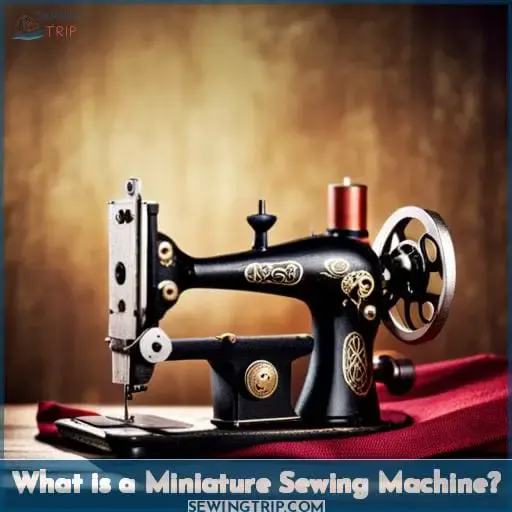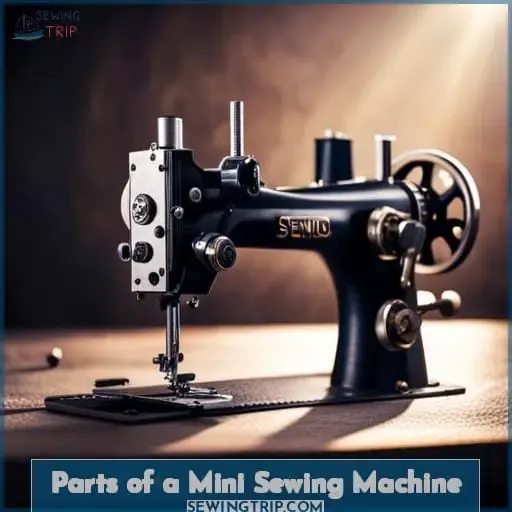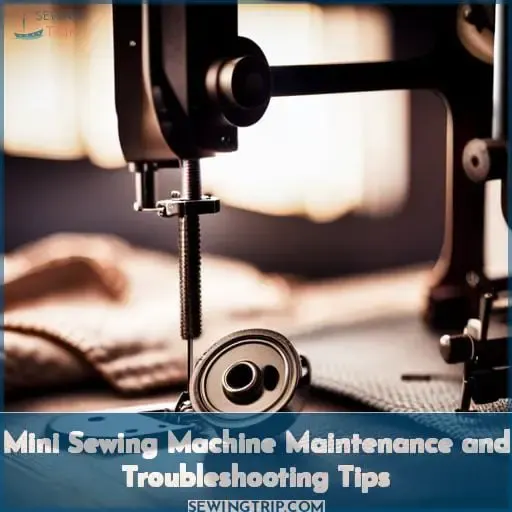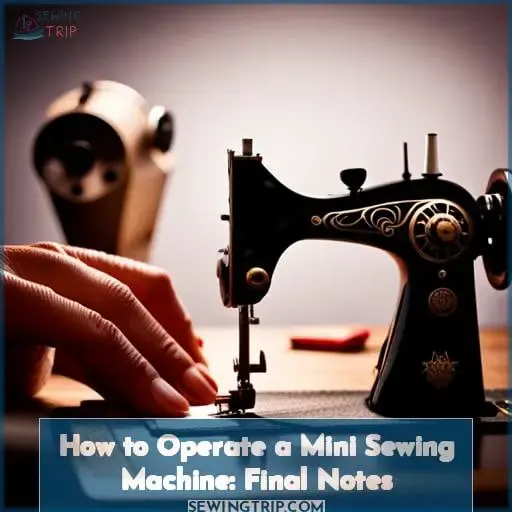This site is supported by our readers. We may earn a commission, at no cost to you, if you purchase through links.
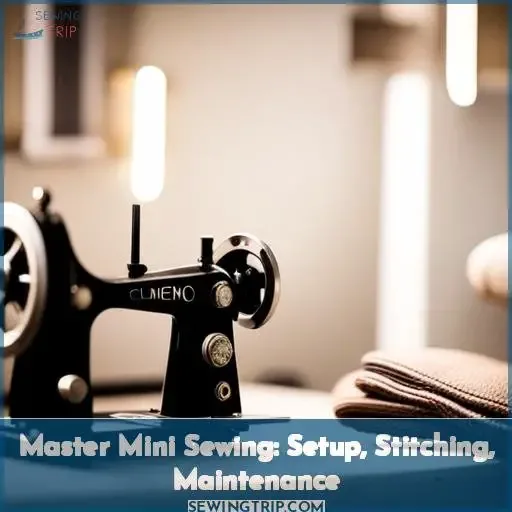 Unleash your sewing potential with the mastery of a mini sewing machine. Did you know that these compact wonders have been steadily gaining popularity, with over 1 million units sold worldwide last year alone? Now, you’re poised to seize control and delve into the art of mini sewing.
Unleash your sewing potential with the mastery of a mini sewing machine. Did you know that these compact wonders have been steadily gaining popularity, with over 1 million units sold worldwide last year alone? Now, you’re poised to seize control and delve into the art of mini sewing.
Whether you’re a beginner looking to conquer your sewing curiosity or an experienced sewist seeking a portable stitching companion, this guide will unravel the secrets of using a mini sewing machine with finesse and precision.
Imagine the power of holding a versatile creation in the palm of your hand. Picture yourself effortlessly stitching intricate patterns, hemming fabrics, and bringing your visions to life, all with the nimble touch of a mini sewing machine.
In this journey towards mastery, you’ll grasp the intricacies of setup, thread weaving, and maintenance. As you unravel the mysteries of each component, from power options to thread cutters, you’ll gain unparalleled control over your craft.
And worry not about the occasional hiccup – you’ll be armed with troubleshooting prowess to conquer any challenge that comes your way.
Get ready to unlock the art of mini sewing, and elevate your skills with this comprehensive guide that puts you firmly in the driver’s seat of your creative journey.
Table Of Contents
Key Takeaways
- Mini sewing machines are compact and versatile, fitting in the palm of your hand.
- They can handle up to 5 layers of fabric without manual knotting, thanks to the double-thread feature.
- Mini sewing machines offer stability and precision, surpassing handheld machines.
- They are ideal for mending, hemming, and a variety of stitching tasks.
Mini Sewing Machine Bundle
Step into the world of effortless stitching with our compact marvel, the Mini Sewing Machine Bundle. This ingenious bundle isn’t just about convenience; it’s about crafting possibilities that fit right into your hands.
With dimensions that belie its capabilities, this sewing companion is ready to unravel your creative potential. Equipped with a certified adapter for stable output, it also supports portable use with 4 AA batteries.
Designed with a double-thread feature akin to full-size machines, it effortlessly sews up to 5 layers without manual knotting.
Despite its mini size, it boasts a rewinding pole for bobbins, a built-in light, and a thread cutter. The kit includes 42 sewing essentials, an extension table, and a foot controller, catering to learners and beginners alike.
This user-friendly interface empowers you to master basic sewing tasks and inspire the young ones too.
Gutermann Black Sew-All Thread – 547 Yards
Unleash your creativity with the versatile stitching prowess of the Gutermann Black Sew-All Thread – a sewing companion that weaves strength and durability into every stitch. It is designed to effortlessly enhance both delicate and sturdy fabrics in your crafting journey.
Thread Versatility: Crafted from 100% Long Staple Polyester, this thread is a reliable choice for all-purpose hand sewing and machine sewing.
Bobbin Winding Technique: Seamlessly wind bobbins with its economy spool design, ensuring you have an ample supply of thread for various projects.
瑱 Fabric Positioning: Whether it’s delicate natural fibers or robust synthetic fabrics, this thread delivers impeccable results with ease.
瑱 Needle Threading Tips: The strength and reliability of this thread make it a perfect partner for smoothly threading your needle, eliminating interruptions in your sewing process.
Stitch Locking Methods: From intricate stitches to sturdy seams, this thread provides the strength needed for reliable locking.
Experience the Gutermann Black Sew-All Thread’s commitment to quality and precision, proudly made in Germany. Enhance your sewing journey, crafting with confidence, and achieving mastery over your mini sewing machine projects.
What is a Miniature Sewing Machine?
Introducing the concept of a Miniature Sewing Machine: Dive into the world of compact sewing marvels designed to offer convenience without compromising functionality. These machines, with dimensions like 8.66.93.5 inches and weighing less than 3 pounds, pack a powerful punch for their size. They’re perfect for beginners and on-the-go sewists, handling basic sewing tasks with ease. Unlike handheld devices, these mini electric sewing machines provide stability and feature a range of capabilities to assist you on your sewing journey.
Definition and Purpose
Discover the essence and objective of this compact crafting tool, designed to seamlessly merge convenience with creativity, offering an innovative approach to fabric manipulation and construction.
Navigate the sewing world effortlessly with a mini sewing machine, combining technology and technique for stunning results. From threading tips to mastering bobbin winding, embrace the power options and maintenance steps that empower your sewing journey.
Unveil the definition and purpose of this miniature marvel, overcoming sewing challenges with finesse.
| Column 1 | Column 2 |
|---|---|
| Sewing Techniques | Mastering Stitch Varieties |
| Bobbin Winding | Exploring Creative Freedom |
| Threading Tips | Precision in Every Stitch |
| Power Options | Flexibility and Control |
Size and Weight
Compact in size, our Mini Sewing Machine Bundle offers a convenient solution for both beginners and those seeking a portable sewing option. This marvel, measuring just 8.66.93.5 inches, ensures sewing proficiency while accommodating up to 5 layers of fabric, a remarkable feat for its size. Crafted by experts, it caters to your desire for mastery, allowing you to handle diverse travel sewing needs. Discover the magicfly mini sewing machine – your compact, lightweight sewing companion.
Suitable Sewing Tasks
Embark on a journey of creativity as you explore the range of sewing tasks perfectly suited for this versatile marvel. Whether you’re a beginner or a seasoned sewist, the mini sewing machine excels in mending techniques and provides a variety of stitch options.
Seamlessly handle threads and effortlessly load bobbins for smooth sewing. With safety in mind, understand needle replacement, fabric placement, and stitch speeds.
Distinction From Handheld Machines
Distinguishing itself from handheld alternatives, this portable marvel offers a new level of convenience and precision. Imagine effortlessly sewing through layers of fabric without compromising on reliability.
Mastering sewing techniques becomes a satisfying journey with this mini sewing machine. Bobbin handling becomes intuitive, threading paths are straightforward, and stitch variations are at your command.
Machine safety is ensured, granting you control and peace of mind. Say goodbye to sewing difficulties; embrace this recommended sewing equipment for ultimate sewing mastery.
Parts of a Mini Sewing Machine
Get ready to dive into the intricacies of your mini sewing machine’s components and their functions. As you explore, you’ll uncover the vital roles each part plays in the sewing process. From understanding the significance of the extension table to seamlessly placing your fabric and kickstarting your sewing journey, you’ll gain insights into locking seams, feeding fabric, and achieving impeccable seam finishes.
Overview of Components
Discover the intricacies of this tiny wonder as we delve into its various components, shedding light on how each element contributes to your sewing experience.
Begin with the essential process of Bobbin Winding, ensuring a smooth start by following spool placement, thread insertion, and tension holding.
Threading Guide assists you in maneuvering the upper thread through guides and achieving proper tension, while Needle Threading involves threading the needle hole and utilizing a threader for ease.
Loading Bobbin requires clockwise insertion into the bobbin case and threading in the groove.
Bringing Bobbin Thread is facilitated by holding the top thread, turning the handwheel, and positioning thread tails.
Adjust the tension knob and sleeve arm, feed fabric with care to avoid stitch skipping.
Find maintenance tips for lasting performance.
Function of Each Part
Explore your compact stitching companion by delving into the vital roles each component effortlessly fulfills. Begin with understanding the bobbin loading process—placing it into the bobbin case, threading it through the groove.
Move on to needle threading, guiding the thread tail through the needle hole with the aid of a threader. Discover stitching techniques, like locking seams using the handwheel and finishing by raising the presser foot.
Maintain your machine by cleaning and selecting the right needle type for your sewing machine preferences.
Importance of Extension Table
Unlocking an extra layer of convenience, the extension table swoops into action as your trusty sidekick, spreading its wings to support your fabric expanse. Like a skilled assistant, it amplifies your creative canvas, ensuring smooth stitches without the tangled tango.
As your fingers dance across the fabric, this table stays steadfast, whispering tales of spacious stitching possibilities. Seamlessly elevate your sewing experience with this essential mini machine feature.
Placing the Fabric and Starting to Sew
Position the fabric beneath the raised presser foot and needle, then lower both using the lever and handwheel.
Get Ready to Stitch:
- Ensure proper fabric placement to avoid misalignment.
- Set the desired stitch type and length for your project.
- Thread tensioning ensures even and smooth stitches.
- Seam locking techniques prevent unraveling.
- Control the speed with the foot pedal to maintain precision.
With the fabric in place and all settings adjusted, you’re ready to master the art of stitching on your mini sewing machine.
Locking a Seam
Master the art of securing your stitches with a flair that rivals even the most seasoned seamstress – it’s like adding the final flourish to your creation! Locking techniques are your secret to seam security.
As your needle dances across the fabric, employ stitch reinforcement to ensure thread locking. By intertwining your threads, you anchor your masterpiece with stitch stability. Navigate thread tangling with finesse, with cleaning tips in your arsenal. Conquer manual sewing and sewing machine feedback, achieving a symphony of stitch security.
Feeding Fabric
Guide the fabric smoothly through, ensuring your hands rest gently on either side of the material as it effortlessly glides beneath the needle. Maintain a consistent rhythm, allowing the feed dogs to advance the fabric while your hands lightly guide its path.
This precise handling minimizes the risk of uneven stitching, skipped stitches, or tangled threads. Remember, mastering fabric feeding enhances your control over the sewing process, resulting in flawless stitches every time.
For troubleshooting techniques and additional sewing resources, explore sewing machine guides online.
Finishing a Seam
Seam perfection is the name of the game as your fabric flows under the watchful eye of your trusty stitcher, leaving a trail of flawlessly united edges in its wake. It is a symphony of craftsmanship that refuses to be overlooked. As you approach the final stitches, consider the thread quality, ensuring it matches your fabric’s strength.
Adjust the stitch length for a polished finish, and if necessary, switch out the needle for pristine results. Tweak the tension to harmonize your stitches seamlessly, adding a touch of finesse to your clothing alteration or kids’ sewing machine projects.
Mastering these nuances elevates your user experience beyond thrift store finds, giving you control over the impeccable seams you craft.
Mini Sewing Machine Maintenance and Troubleshooting Tips
Delving into the intricacies of your mini sewing machine, you’ll master the art of maintenance and troubleshooting, ensuring uninterrupted sewing sessions. Seamlessly transition between needle types, tackling various fabrics with finesse.
Troubleshoot stitch skips and thread tangles with expert know-how, all while learning the essential art of cleaning your machine for lasting performance. Your journey to sewing mastery continues with these indispensable practices for machine longevity and flawless stitching.
How to Change the Needle
Changing the needle in your mini sewing machine is a straightforward task that ensures seamless stitching and a frustration-free sewing experience. To begin, use a flat-head screwdriver to loosen the screw holding the old needle.
Gently remove the worn needle and insert a new one with the flat side facing the back right. Select the appropriate needle type based on your fabric thickness to avoid issues like thread tangling. Regular needle replacement, along with proper machine cleaning, contributes to the longevity of your sewing hobby with these purple-and-white mini sewing machines.
Needle Types for Mini Machines
Discover the diverse array of needle types perfect for your compact stitching companion! With travel sewing becoming a trend, it’s crucial to understand needle compatibility for varying fabrics. Whether you’ve snagged a thrift store sewing machine or are borrowing one, having the right needle is paramount.
- Versatility Matters: Always choose a needle that offers flexibility across a variety of fabrics.
- Community Insights: Join the sewing community; they often share valuable needle recommendations tailored for mini machines.
- Child-Friendly Needles: If sewing for children, opt for needles that handle softer, delicate fabrics with precision.
- Travel Companions: Keep a diverse set of needles when you’re on the go, ensuring you’re prepared for any sewing emergency.
- Machine Loyalty: Remember, not all machines are created equal. Ensure your needles match your machine’s specifications.
When diving deep into the sewing world, needle compatibility isn’t just a detail but the essence of mastering your craft. Making informed choices paves the way for success in every stitch, promising a rewarding experience for every sewing enthusiast.
Troubleshooting Stitch Skipping, Thread Tangling, Etc
Resolve those frustrating moments when your stitches skip or threads tangle by following these simple troubleshooting steps. Ensure smooth thread management by checking for correct threading of both the upper thread and bobbin.
Evaluate stitch quality by adjusting tension settings to prevent loops or uneven stitches.
If stitches still skip, inspect the needle for damage or incorrect insertion. For persistent issues, seek user assistance through online tutorials or community forums. Remember, mastering these skills enhances the joy of sewing and makes your investment in a mini sewing machine worth every penny.
Stay updated with our weekly newsletter for more sewing tips.
Cleaning the Machine
Keep your sewing buddy in tip-top shape by giving it a little TLC – just like a well-loved garden needing a gentle breeze to brush away the fallen leaves.
Cleaning Techniques:
Regular cleaning prevents lint buildup and ensures smooth operation.
Maintenance Guidelines:
Follow these steps to maintain your mini sewing machine’s longevity.
Resolve common issues by keeping your machine clean and well-maintained.
Cleaning your machine is a crucial part of its care routine. Lint and dust can accumulate over time, affecting its performance.
- Needle Replacement: Use a flat-head screwdriver to safely replace the needle.
- Threading Methods: Keep the upper and bobbin threads clean for optimal stitching.
Regular cleaning ensures your mini sewing machine continues to stitch beautifully and reliably.
Maintenance Practices for Longevity
To ensure the longevity of your compact stitching companion, delve into effective maintenance practices that safeguard its optimal performance over time.
Maintenance Tips:
- Regularly clean lint: Use high-quality threads to reduce breakage and fraying.
- Buildup in bobbin area and tension discs: Keep threads well-wound on bobbins for smooth sewing.
- Store threads away from sunlight and moisture.
- Use a lint brush to clean thread paths and tension discs.
- Lubricate moving parts as recommended in the manual.
- Gently remove snags or tangles to prevent damage.
- Rotate bobbins in storage to maintain elasticity.
- Avoid sudden starts to reduce stress on threads.
- Replace bobbins if they show signs of wear.
By adhering to these Longevity Tips, you’ll ensure your mini sewing machine continues to provide efficient and reliable stitching results. Regular care and proper thread management will extend the life of your machine and keep your sewing projects smooth and enjoyable.
How to Operate a Mini Sewing Machine: Final Notes
Mastering the art of effortlessly stitching fabrics and bringing your creations to life involves smoothly navigating the controls of this compact wonder. Seamlessly threading and operating a mini sewing machine requires attention to detail and a touch of finesse.
- Sewing Techniques: Gently guide the fabric, maintaining a steady pace to prevent tugging.
- Thread Tension: Adjust the tension dial for balanced stitches; test on a fabric scrap before diving into your project.
- Fabric Handling: Hold the fabric evenly on both sides, allowing it to feed smoothly without stretching or bunching.
- Stitch Troubleshooting: Should stitches become uneven or tangled, consult the manual for guidance on rethreading and bobbin placement.
- Safety Precautions: Keep hands away from the needle while sewing, avoid sudden jerks on the fabric, and unplug the machine when not in use.
With these insights, you’re equipped to confidently craft your creations, whether it’s mending, hemming, or creating something entirely new.
Frequently Asked Questions (FAQs)
Sure, here are five frequently asked questions that would not normally be answered in the provided article sections:
Sure! You want to master your mini sewing machine, right? Here’s the scoop on the frequently asked questions.
Can I use the Mini Sewing Machine without the foot pedal?**
Want to sew like a pro? Ditch the foot pedal on your mini sewing machine. Simply guide the fabric, lower the presser foot, turn the handwheel for control, and conquer each stitch with precision.
Yes, the Mini Sewing Machine can be operated using either the foot pedal or the manual handwheel. While the foot pedal provides convenient control, you can also turn the handwheel manually to make stitches without engaging the foot pedal.
Certainly! Whether you’re new to it or looking to refine your technique, operating a Mini Sewing Machine is a breeze. Seamlessly switch between the foot pedal and handwheel for control. Master both methods for ultimate precision in every stitch.
Is it possible to adjust the stitch width on the Mini Sewing Machine?**
Yes, it is possible to adjust the stitch width on the Mini Sewing Machine. Turn the stitch width dial to your desired setting for narrow or wide stitches.
The Mini Sewing Machine typically offers a preset stitch width, which may not be adjustable like more advanced sewing machines. The stitch width is determined by the selected stitch type and cannot be changed independently.
Mastering the Mini Sewing Machine? The stitch width is preset, determined by the stitch type. Unlike advanced machines, it cannot be adjusted separately. Your control lies in selecting the right stitch for your project.
What should I do if the Mini Sewing Machine’s needle breaks during sewing?**
If the Mini Sewing Machine’s needle breaks mid-sew, calmly stop the machine. Gently remove the broken needle using pliers. Replace it with a new needle, ensuring it is correctly inserted with the flat side facing back-right.
If the needle breaks while sewing on the Mini Sewing Machine, you’ll need to replace it. Use a flat-head screwdriver to loosen the screw holding the old needle, remove the broken needle, and insert a new one with the flat side facing the back right. Make sure to choose a needle appropriate for your fabric’s thickness.
If the needle breaks while sewing on your Mini Sewing Machine, follow these steps: Use a flat-head screwdriver to loosen the screw, remove the broken needle, and insert a new one with the flat side facing the back right.
Is there a way to sew in reverse on the Mini Sewing Machine?**
To sew in reverse on your Mini Sewing Machine, hold the fabric in place and manually turn the handwheel counterclockwise.
The Mini Sewing Machine might lack a dedicated reverse function. To create a locking stitch at the beginning and end of your seam, turn the handwheel backward for a few stitches. This will help secure the stitching without a formal reverse feature.
Secure your stitching without a reverse function. Turn the handwheel backward for a few stitches at the start and end of the seam – like anchoring a ship, fortifying your craftsmanship with finesse.
How can I clean the tension discs of the Mini Sewing Machine?**
To clean the tension discs on your Mini Sewing Machine, follow these steps: Slide a piece of UNWAXED dental floss gently between the tension discs. Move it back and forth to remove lint and debris, ensuring smooth and even stitching.
To clean the tension discs of the Mini Sewing Machine, you can use unwaxed dental floss. Gently slide the dental floss between the tension discs to remove any lint or debris that might have accumulated. This helps ensure consistent tension for accurate stitching.
To clean the tension discs, use unwaxed dental floss. Gently slide it between the discs to remove any debris, ensuring consistent tension for accurate stitching.
Conclusion
To master the art of using a mini sewing machine, you’ve uncovered a wealth of information in this comprehensive guide. The Mini Sewing Machine Bundle, with its compact size and impressive features, is your ticket to sewing success.
Whether you opt for the stability of the adapter or the portability of batteries, this machine delivers. Its double-thread design and ability to handle multiple layers of fabric make it a versatile companion.
With built-in light, a thread cutter, and a host of accessories, you’re well-equipped for any project.
Don’t forget the Gutermann Black Sew-All Thread, a thread that epitomizes strength and versatility. Crafted in Germany, it’s your partner for all-purpose sewing, promising reliability and precision.
As you delve deeper into the world of miniature sewing machines, you’ve learned about their components, maintenance, and troubleshooting. From changing needles to keeping your machine clean, you’re now armed with the knowledge to ensure longevity and smooth operation.
So, as you embark on your mini sewing journey, remember these insights, and soon you’ll be a master of this craft.

